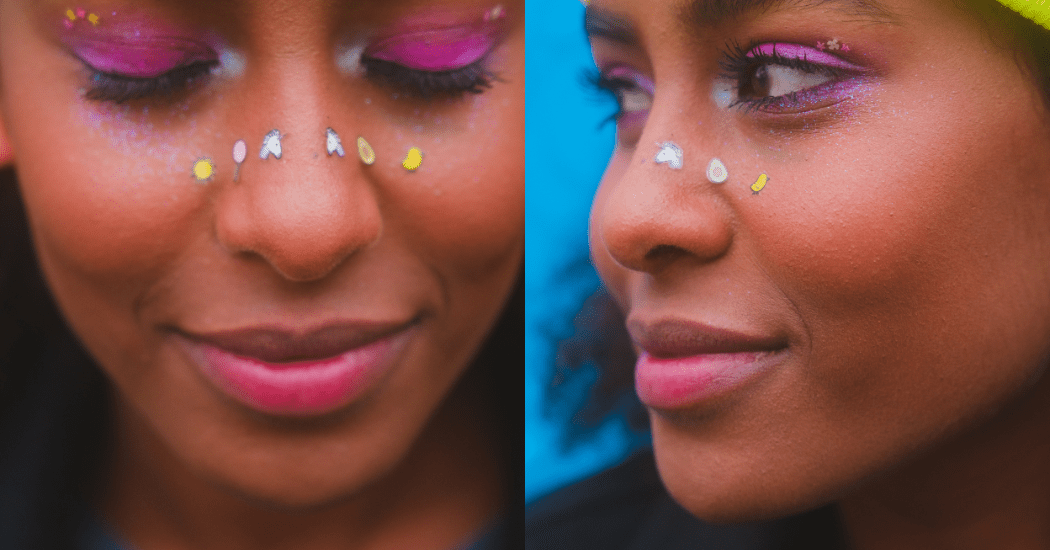Cakey makeup is a common concern when it comes to makeup. Cakey. The stiff plaster-like feeling you get when you apply too much makeup.
Whether you are a makeup lover or an expert, the knowledge about avoiding cakey makeup will help you. In Orane, where the makeup students master the makeup skills at various locations throughout India, this question often crops up during their makeup classes.
When your face looks exhausted, makeup will always save the day. No doubt, makeup is essential for every woman’s cool looks. However, the same makeup can turn into a foe when it does not work according to your will. It can happen with any type of makeup look, such as nude, fantasy, and bridal, among others.
When was the last time it happened to you that your face seemed like it was covered with a cracked mask? Why does your makeup turn cakey?
Actually, it is your foundation that’s working against you. Well, you know you can’t do without it either, as it is the one that hides your acne and hyperpigmentation by concealing them. So what you need to get rid of is not the foundation; it’s the wrong application.
There’s nothing wrong with your product in most cases. It’s just that the base of your makeup needs to blend with your skin impeccably. When it does not, you end up having cakey makeup.
Thankfully, there are ways to avoid the cakey makeup look due to this issue. Let’s discuss.
Here are Five Simple Tips to Apply your Foundation Correctly and Avoid a Cakey Look.
Skin Preparation
The start of good makeup is taking great care of your skin. Your skin will get the best look with foundation only if it is healthy underneath. Most of the time, when you’re in a hurry, you’ll tend to bypass a few steps. For best results, you will have to exfoliate your skin beforehand so the dead or dry skin is peeled away but remember to always be gentle so that you don’t irritate your face. Secondly, apply toner to tranquilize your face and avoid inflammation after being exfoliated. Above all, moisturize your face. You may think it is time to apply your foundation, but hold on; we have one more trick that will keep your makeup for longer periods.
Keep the primer in the line-up, as it’s key to a smooth, long-lasting finish. Primers are amazing at highlighting the application of any makeup tool that follows. As you use them on your lips and eyelashes, try them on your face before applying the foundation and realize the difference it makes.
Some people apply moisturizers that are gel-based, and they work as efficiently, so feel free to choose whatever suits you best. Always give your moisturizer time (as long as 15 minutes) to absorb into your skin before applying foundation. Otherwise, you can end up with a streaky mess.
Apply moisturizer day and night. Moisturizers immediately revive the skin and soak up any dry patches around the face. When you have dry skin and apply foundation, the product tends to stick to these dry areas and creates a flaky, uneven cakey look.
Shade Selection
It’s difficult to find the “perfect shade” of foundation. This is very common among most girls and women; they don’t properly test the shade before buying. Even if they think they do, it’s not tested in the way it should be. Take your time to examine the different shades.
First of all, you test it in natural light that will make the shade of the foundation appear as it is, without any effect from the hard lighting that usually stores have. Second, most of you take the easy road by putting a portion of the foundation on your wrist or hands to test the color. The skin tone on your hands or wrist does not necessarily match that of your face. Test the shade of your chosen foundation on your face instead, and it will no longer fail you.
One more thing to consider while selecting the right foundation shade for your skin is to pick neither lighter nor darker shade than your skin. It should look as if you haven’t applied anything at all. It may take you a bit longer than you are used to to find the right foundation, but be rest assured, it is worth the extra minutes.
Blending The Skin Type and The Foundation Formula
The formula of the foundation you are using plays a very significant role. In case you choose the wrong one for your skin type it will end up turning your makeup cakey. Face skin is usually sensitive and it can react to whatever you apply to it. So, you will have to be cautious in choosing the right foundation for you. For example, in case you use a matte foundation and your face skin is of dry type, it is going to highlight the dry patches on your face. On the other hand, using shine or gloss products on oily skin can irritate your skin.
It can choke your pores and may cause acne. So, one solution is that for your oily skin face, use matte products otherwise, the excess oil excreted by your skin will make your face look shiny and make your makeup cakey. In contrast, products that are creamy and have a radiant finish will work well on a dry face, as they will provide the needed brightness and keep your skin hydrated as well.
“One of the easiest ways to get a flawless and natural application of foundation is to choose a liquid formula instead of a cream or a powder,” says celebrity makeup artist Joey Camasta. “Moreover, liquid foundations are easier to apply, are better to build on, and they mimic the texture of actual skin,” as she puts it.
The Importance of The Brush Applicator & The Blender
A common mistake lots of women make that causes cakey makeup is using their fingers to apply the foundation. It doesn’t just crumble your makeup but also leads to undesirable contagions due to the dirt or bacteria that your finger may collect. Because your finger can spread the bacteria all over your product and harm your skin. Especially if you are prone to chronic acne, you will worsen it even further.
And there is no secret to avoiding this infection. Simply use a brush applicator for applying your foundation; it will be safer for the skin, and it will also spread the product more evenly. After you are done with the application, you can use a damp sponge to finish off by removing the unwanted makeup that gets piled on the surface of your skin.
Makeup artists or students completing makeup artist courses recommend that using a damp sponge can minimize the cakey-ness. Tapping a damp sponge all over your face will even out the coverage and diffuse the product.
Excess is Always Unwanted
Instead of stuffing it all on at once, work it in light, thin layers. This allows you to stand back and assess whether you really need a full face of base or can just spot apply. It also gives your makeup some time to settle and allows you to see how your skin reacts to a particular formula. If your foundation starts to flake in certain areas, you can add some moisturizer. Or if the top of the nose is getting shiny, you can add a bit of setting powder.
Applying too much of anything is never a good idea, and the same goes for the foundation. Don’t apply heavy layers because then the chances of getting cakey makeup will increase. Why put the foundation all over your face if not required? Most women believe that they should apply foundation to their whole face. However, it is not the right approach If you have flaws all over your face, then they need complete coverage. Otherwise, you can apply it only to the spots that need coverage. Your face won’t look odd because the right foundation will blend in with your skin anyway. Remember, less is more.
Wrapping Up
To summarize, to avoid a cakey makeup look, careful foundation application is needed and this blog sheds light on the same. It states that one can achieve a smooth, long-lasting finish through proper skin preparation, which includes gentle exfoliation, toning, and moisturizing with a primer. Moreover, it also reveals that, when selecting a foundation shade, testing it on your face in natural light is crucial for a seamless blend.
Further, consider your skin type when choosing a foundation formula—matte for oily skin and creamy for dry skin. Utilize the right tools, such as a brush applicator and damp sponge, to prevent contamination and ensure even coverage. Lastly, avoid excess application by working in light layers, allowing time to assess the need for a full face of the base. Remember, less is more for a natural, and no cakey appearance.
Moreover, if you have gone through this blog, you may have an interest in beauty courses for which Orane Beauty Academies are just perfect.












